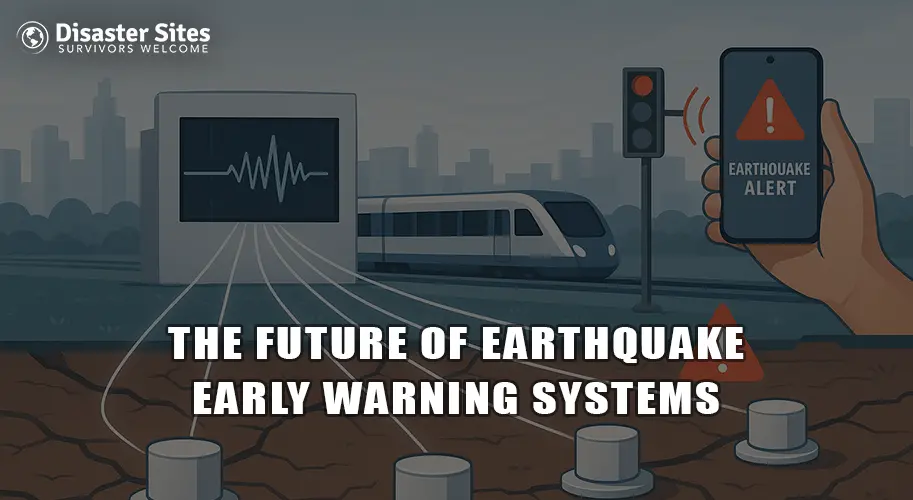We use cookies to personalise site content, social media features and to analyse our traffic. We also share information about your use of this site with our advertising and social media partners.
FEATURED
SPONSORED
VERIFIED

Sat at 10:16 AM -
8 minutes, 26 seconds
-108 Views 0 Comments 0 Likes 0 Reviews

Earthquakes may happen at any time and typically without any warning, they do an abrupt and massive amount of damage to homes, roads, and lives. How can we improve? Earthquake Early Warning systems can help. EEW systems that observe the first indications of seismic activity and alert the public seconds or even minutes prior to shaking arriving in populated areas providing a community with time to react.
An advance of a few seconds can make a real impact. People can drop, cover and hold on. Trains can be slowed or stopped. Gas lines can be shut off. Surgeries can be temporarily stopped in hospitals. Injuries and consequential damages can be reduced. Businesses and other emergency services can prepare to evacuate in an orderly manner and can limit their loss.
With the development of technology, EEW systems are becoming faster, smarter, and more reliable. Scientists will use artificial intelligence, dense sensor networks, and cloud-based alert systems to help predict and report earthquake risk in real time and give communities more chances to be safe.
Earthquake Early Warning (EEW) systems detect the first signals from the earthquake known as P-waves. P-waves travel quicker than the period of heavy shaking. Sensors detect this wave first and provide a small but critical opportunity.
Once a sensor detects a P-wave, the information is sent immediately or within milliseconds to a computationally processing system. The system very quickly determines the geographical location, magnitude, and expected shaking intensity. Finally, the system sends alerts to people, industrial users, and emergency service responders within the region.
Existing EEW systems, like Shake Alert in the US and J-Alert in Japan, provide human beneficiaries with alerts which can be from a few seconds to nearly a minute or more before heavy shaking is anticipated to occur, sometimes with enough time to formulate multiple safety actions like stopping trains, shutting down gas lines, or travelling to safe locations for example.
EEW systems offer a community the precious option to prepare and react before disaster occurs given the various challenges of integration of fast and reliable sensor data and reliable communication networks.
To better understand earthquake impacts and survival, read Earthquakes: Understanding the Phenomenon and How to Stay Safe.
Although earthquake early warning systems save lives, they are not without limitations. Some of these limitations include the following:
It is important to understand limitations that develop around the sensors so that scientists and governments can make improvements. New technologies and broader sensor networks are being developed to address these limitations and produce faster stay safe, and more accurate early warning systems.
See how preparedness issues affect communities in Why Texas Keeps Ignoring Disaster Preparedness – Despite Facing the Worst.
The future of Earthquake Early Warning systems looks bright owing to emerging technologies that can accelerate the alert process, and improve the accuracy:
Using all of these technologies combined into the components set, Earthquake Early Warning systems can give earlier warnings, better alerts, thus giving the public more time to protect themselves, their families and communities.
In the years ahead, Earthquake Early Warning (EEW) systems will not simply warn individuals; they will act directly with critical infrastructure to minimize damage. For example:
Integration empowers communities to immediately and efficiently use automated systems to react to earthquake alerting protocols to reduce injuries and reduce damage to property, and protect the environment.
For examples of government and city-wide coordination, check Government Strategies for Effective Natural Disaster Management.
Despite advances in technology, EEW systems will operate under very difficult conditions. The first obstacle to address is the cost of deployment and maintenance for widespread sensor networks; it is exacerbated in poorer regions who may not manage even sensors. Second, it is vital that all populations receive timely warning notification, which is more difficult in rural and underserved areas. The effects of technical issues such as false alarms or a delay promising anticipation and response, will also negate system trust. If the warning is received timely, the systems will only be effective, if users are educated on how to act swiftly and correctly. Overcoming these issues will be critical to making EEW systems worldwide reliable.
Clearly, Earthquake Early Warning systems have already demonstrated that even a couple of seconds makes a difference when it comes to saving lives, resources, and improving resilience. Now that we have new technologies such as AI, IoT, satellite-based imagery, and cloud alerts, it is clear that the future of earthquake early warning systems is even better and even more reliable.

“To assist disaster survivors by providing a source for them to come together in time of need, to aid in the listing of events, information and other forms of assistance, and continuing support through the recovery process.”
Share this page with your family and friends.